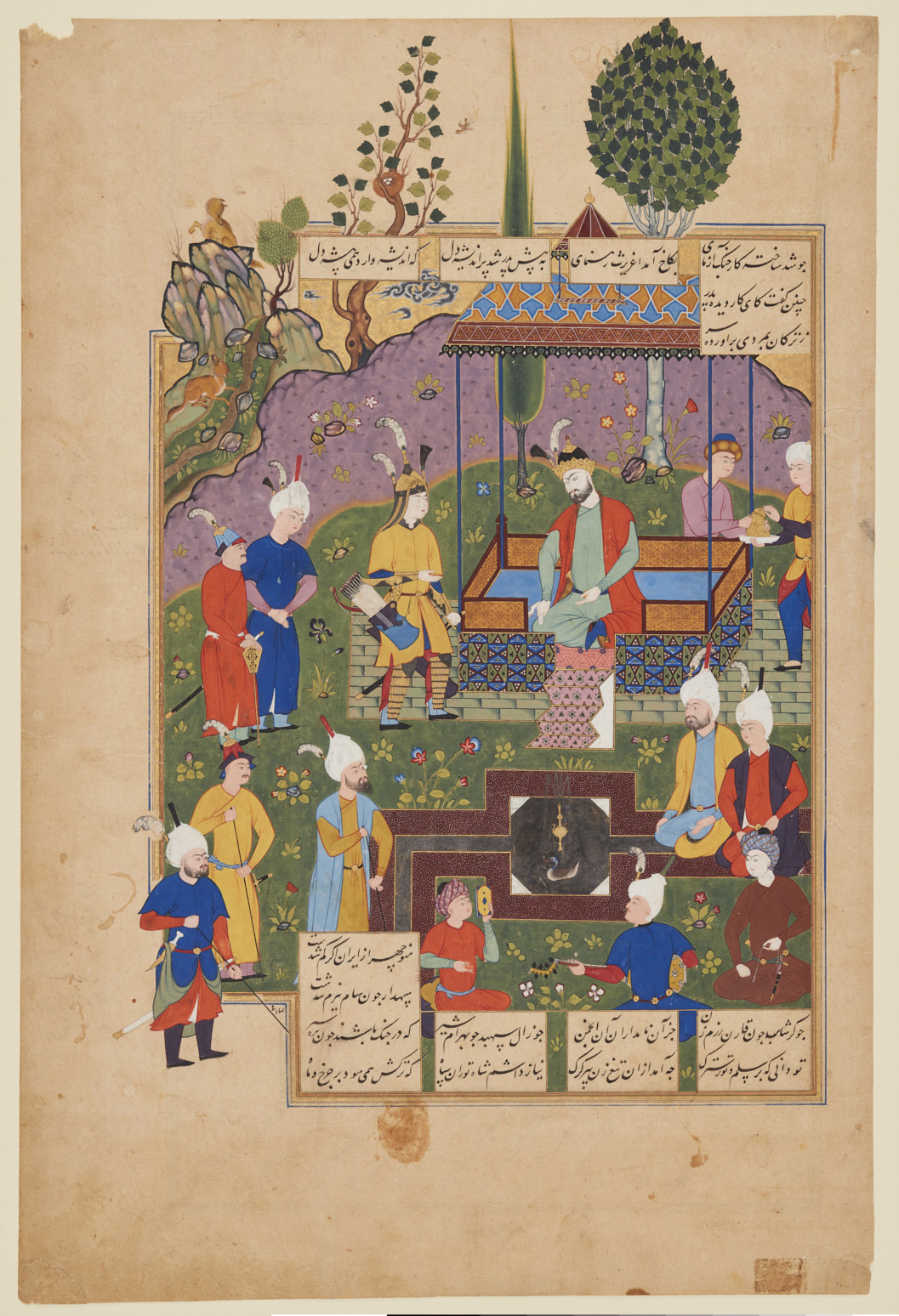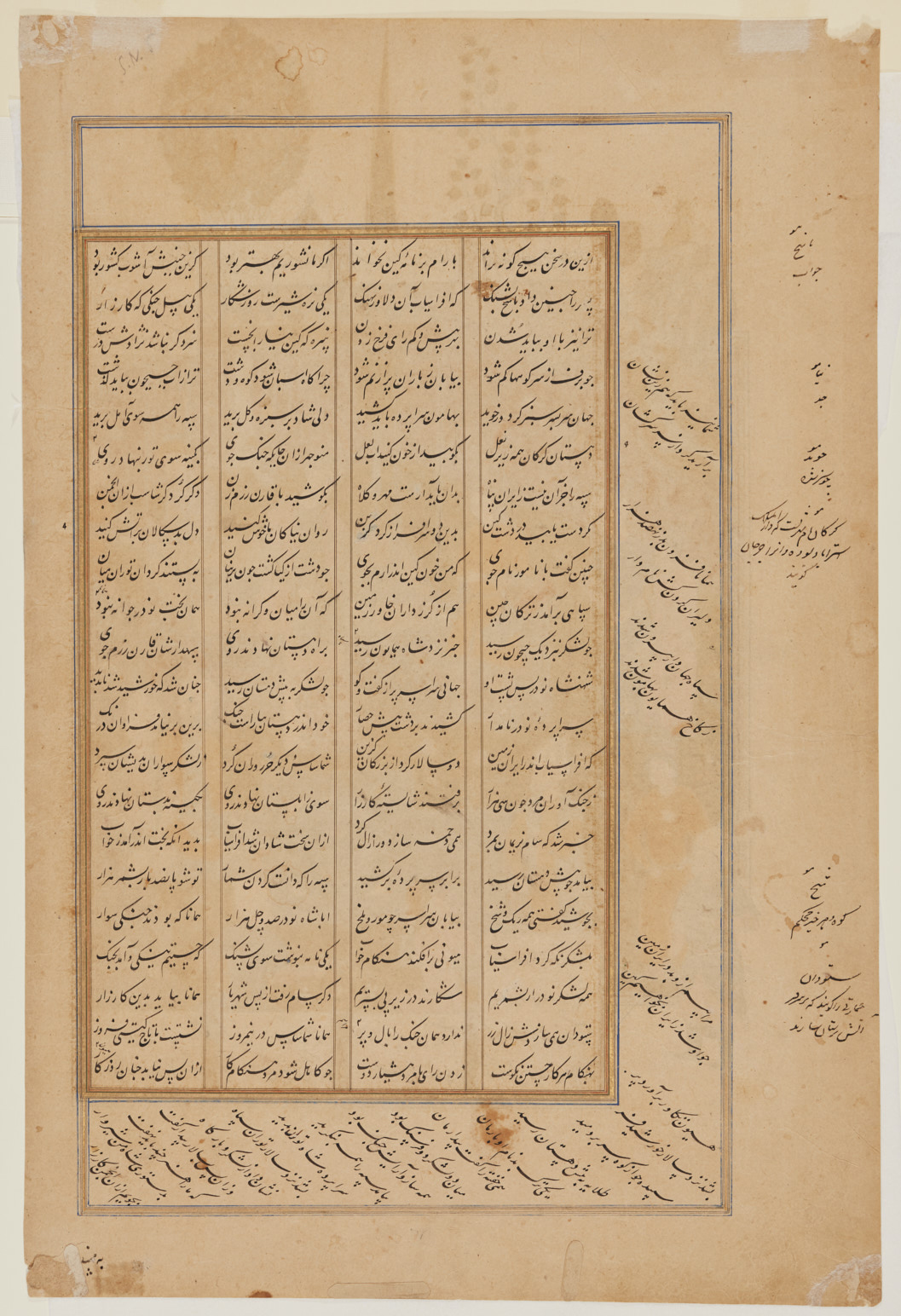Click on the image to zoom
Pashang discusses the invasion of Iran
Folio from the Shahnameh (Book of Kings) of Shah Ismail II
- Accession Number:AKM72
- Place:Iran, Qazvin
- Dimensions:45.6 x 30.5 cm
- Date:1576–77
- Materials and Technique:opaque watercolour, gold, silver and ink on paper
The miniature painting “Pashang discusses the invasion of Iran” is from a dispersed illustrated manuscript of the Shahnameh (Book of Kings), completed by the Persian poet Firdausi ca. 1010. Shah Ismail II (r. 1576–77) [1] commissioned the manuscript, following the examples of his grandfather, Ismail I, and father Shah Tahmasp, both of whom showed interest in Firdausi’s epic at one time during their reigns. Ismail II’s Shahnameh can be seen as a link in the chain of royal copies of the Book of Kings, after Shah Tahmasp’s spectacular manuscript and forming a bridge to the next period of royal patronage of the epic under Shah ‘Abbas (1587–1629). The manuscript was left unfinished upon Ismail II’s death. However, for a brief period, Ismail II’s atelier employed a number of artists who contributed to the illustration of the Shahnameh, including Siyavush, Sadiqi Beg, Naqdi, Murad Dailami and Mihrab. These artists did not sign their work, and attributions were probably made by the contemporary royal librarian. This is one of seven paintings in Ismail II’s Shahnameh attributed to Sadiqi Beg (d. 1610), the former member of the Safavid military forces (Qizilbash or “redheads”).
See AKM70 for an introduction to the Shahnameh (Book of Kings) of Shah Ismail II.
Further Reading
This painting illustrates an episode after the deaths of Salm and Tur, whose murder of their younger brother Iraj was avenged by Manuchihr. After Manuchihr himself is killed, Pashang converses with his son, Afrasiyab, discussing the opportunity to take revenge by invading Iran, now ruled by the new shah, Nauzar. The young prince, a Turanian hero and the main enemy of the Iranians throughout the first part of the epic, is dressed in yellow and armed for war. He is eager to lead an expedition to Iran at what seems to be a propitious moment.
Although Sadiqi Beg has caught the solemn mood of the occasion (despite the musician playing and the young page studying himself in a mirror) [3] he has evidently not chosen to follow the verbal context of the scene he is illustrating. The text surrounding the painting actually concerns a later moment in the story: once war is decided, Afrasiyab’s wiser brother Aghriras approaches their father and counsels prudence. He draws attention to the fact that the Iranians still have many champions, and that starting another war will merely lead to the destruction of the kingdom. Among these champions, the text names Zal and Bahram, “who were like male lions in battle,” a verse not found in the standard editions of the epic, interpolated beneath the painting.4
Like other paintings in this copy of the Shahnameh (see AKM71 and AKM99), “Pashang discusses the invasion of Iran” extends into the left-hand margin. From there, the painting is taken up into the columns between the text and breaks through the single ruled margin. The attribution to Sadiqi appears in the angle between the bottom left of the frame and the stick held by the attendant. The rocky outcrops and animals, here two foxes, are characteristic of Sadiqi’s hand. The facial features and posture of the Turanian ruler Pashang are very similar to those of Faridun in another painting attributed to Sadiqi, “Faridun with the envoys of Salm and Tur” (AKM99). Anthony Welch contrasts the warmth and animation of the reception of Salm and Tur’s embassy [2] with the cold, stiff, and rather disturbing quality of Pashang’s depiction.
The choice of subject is itself unusual, if not unique. “Pashang discusses the invasion of Iran” in Ismail II’s Shahnameh is the first a depiction of this episode, and although the iconography is very general (a standard court scene with the enthroned monarch), Sadiqi Beg must have given some thought to how he would depict the topic, which initiated of a long series of wars between the Persians and the Turks in the Shahnameh.
The Aga Khan Museum Collection has eight folios from the Shahnameh (Book of Kings) of Shah Ismail II, see AKM70, AKM71, AKM72, AKM99, AKM100, AKM101, AKM102, AKM103.
— Charles Melville
Notes
[1] Shah Ismail II was the third ruler of the Safavid dynasty (1501–1722). Reuniting the eastern and western provinces of Iran, the Safavids introduced Shiite Islam as the official state religion. Ismail II, son of Tahmasp (r. 1524–76), seems to have been inclined to return to Sunnism, but in this and his artistic patronage he was perhaps simply seeking to distance himself from his father’s regime. He was murdered after ruling for 18 months.
[2] Welch, Artists for the Shah, 79–80.
[3] Or possibly, reciting poetry from an anthology.
[4] See Shahnameh, ed. Mohl, “Nauzar,” after verse 106; ed. Khaleghi-Motlagh, “Nauzar,” after verse 93.
References
Khaleghi-Motlagh, Djalal, ed. Shahnameh. Costa Mesa, CA: Mazda Publishers in association with Bibliotheca Persica, 1992.
Mohl, Jules, ed. Shahnameh (Livre des rois). Paris: Impr. Nationale, 1876–78.
Welch, Anthony. Artists for the Shah. Late Sixteenth-Century Painting at the Imperial Court of Iran. New Haven and London: Yale University Press, 1976. ISBN: 9780300019155.
Note: This online resource is reviewed and updated on an ongoing basis. We are committed to improving this information and will revise and update knowledge about this object as it becomes available.




